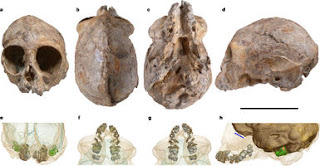A new Miocene Ape
 |
| Nyanzapithecus alesi, from Nengo et al. 2017 |
There isn't a lot of buzz about this, but I thought it warranted a few comments. A new report in Nature describes a remarkably well-preserved ape cranium from middle Miocene sediments in Kenya. The authors, Nengo and colleagues, used powerful X-rays to observe the unerupted teeth still in its upper jaw. The teeth are really exquisite! The researchers conclude that the fossil, Nyanzapithecus alesi, is 13 million years old (using conventional dating methods) and probably a "stem hominoid." What does all this mean? It's not much of a human "relative" even from the evolutionary perspective.
First of all, the oldest fossil that are most likely hominids (in our biological "family") are 4-5 million years old by conventional dating. There are a few fossils from before this that have been proposed to be hominids, but 13 million years is more than twice as old as the oldest hominids. So at best, from the evolutionary perspective, this new fossil is a very distant relative.
Second, the authors included a tree in their paper (a phylogeny) that purports to show the evolutionary relationships between this new fossil and other living and fossil apes. The tree shows this new fossil Nyanzapithecus is a derived member of a branch that contains a lot of other previously-known fossil apes like Afropithecus. Nyanzapithecus itself is not particularly close to the hominid or hominoid branch of the tree. Certainly no closer than Afropithecus.
What does this mean to human baraminology? Honestly, that's hard to say for sure. I've never done much with the many Miocene apes for two reasons: 1. I haven't had time yet, and 2. There are far more Miocene ape fossils than are described in the literature. I'd rather have a larger sample of taxa (always works better for baraminology), but that would require original research I am ill-prepared to undertake at this time. Despite these reasonable reservations, I doubt that Nyanzapithecus is anything other than another non-human ape.
Read all about it in Nature (if you have a subscription):
Nengo et al. 2017. New infant cranium from the African Miocene sheds light on ape evolution. Nature 548:169-174.
Feedback? Email me at toddcharleswood [at] gmail [dot] com. If you enjoyed this article, please consider a contribution to Core Academy of Science. Thank you.